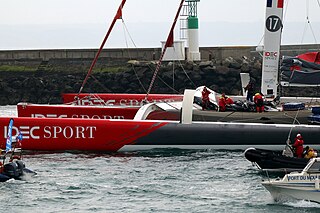
A multihull is a boat or ship with more than one hull, whereas a vessel with a single hull is a monohull. The most common multihulls are catamarans, and trimarans. There are other types, with four or more hulls, but such examples are very rare and tend to be specialised for particular functions.

A trimaran is a multihull boat that comprises a main hull and two smaller outrigger hulls which are attached to the main hull with lateral beams. Most modern trimarans are sailing yachts designed for recreation or racing; others are ferries or warships. They originated from the traditional double-outrigger hulls of the Austronesian cultures of Maritime Southeast Asia; particularly in the Philippines and Eastern Indonesia, where it remains the dominant hull design of traditional fishing boats. Double-outriggers are derived from the older catamaran and single-outrigger boat designs.

The Fastnet Race is a biennial offshore yacht race organized by the Royal Ocean Racing Club (RORC) of the United Kingdom with the assistance of the Royal Yacht Squadron in Cowes and the City of Cherbourg in France.
The Transpacific Yacht Race (Transpac) is a biennial offshore yacht race held in odd-numbered years starting off the Pt. Fermin buoy in San Pedro, California and ending off Diamond Head in Hawaii, a distance of around 2,225 nautical miles. In even-numbered years the Pacific Cup race starts out of San Francisco and is run by the Pacific Cup Yacht Club. Started in 1906 by Clarence W. Macfarlane and hosted by Los Angeles Yacht Club, it is one of yachting's premier offshore races and attracts entrants from all over the world. The race is organized by the Transpacific Yacht Club.
The Single-handed Trans-Atlantic Race (STAR) is an east-to-west yacht race across the North Atlantic. When inaugurated in 1960, it was the first single-handed ocean yacht race; it is run from Plymouth in England to Newport, Rhode Island in the United States, and has generally been held on a four yearly basis.

Éric Marcel Guy Tabarly was a French Navy officer and yachtsman. He developed a passion for offshore racing very early on and won several ocean races such as the Ostar in 1964 and 1976, ending English domination in this specialty. Several of his wins broke long standing records. He owed his successes to his exceptional mastery of sailing and of each one of his boats, to both physical and mental stamina and, in some cases, to technological improvements built into his boats. Through his victories, Tabarly inspired an entire generation of ocean racers and contributed to the development of nautical activities in France.
Phil Morrison is a British boat designer and racer rendered notable by the success of his many designs in many classes since 1967 as well as his own distinguished yacht racing career.
Arthur Piver was a World War II pilot, an amateur sailor, author, printshop owner and renowned boatbuilder who lived in Mill Valley on San Francisco Bay and became "the father of the modern multihull."

Franck Cammas is a French yachtsman. He has lived in Brittany since his victory in the Challenge Espoir Crédit Agricole in 1994. After completing a two-year maths course for the ‘Grandes écoles’, as well as a piano academy, Franck Cammas finally opted for a career in sailing. In 1997, at the age of 24, he won the Solitaire du Figaro and a year later helmed his first trimaran christened Groupama. Despite his late entry into competition, he is one of the most talented and respected sailors in the Ocean Racing Multihull Association world.
Dragonfly Trimarans is a line of trimaran sailboats built by the Quorning Boats shipyard in Skærbæk, near Fredericia, Denmark.55°31′11.97″N9°38′8.08″E
Aksel Magdahl, is a Norwegian yacht racing navigator, author of the tactics that took the boat Ericsson 3 to the victory in the fifth leg of the Volvo Ocean Race. The stage was the longest in the history of the race and it was disputed between the Chinese city of Qingdao and in Rio de Janeiro, Brazil.

Pascal Bidegorry is a French sailor.

The first around the world sailing record for circumnavigation of the world was Juan Sebastián Elcano and the remaining members of Ferdinand Magellan's crew who completed their journey in 1522. The first solo record was set by Joshua Slocum in the Spray (1898).

Loïck Peyron is a French yachtsman, younger brother of the yachtsman Bruno Peyron.
Telstar trimarans is a line of trimarans most recently built by the Performance Cruising Inc shipyard in Annapolis, Maryland.
VPLP design is a French-based naval architectural firm founded by Marc Van Peteghem and Vincent Lauriot-Prévost, responsible for designing some of the world's most innovative racing boats. Their designs presently hold many of the World Speed Sailing records.

The AC72 is a class of wingsail catamarans built to a box rule, which governs the construction and operation of yachts competing in the 2013 Louis Vuitton and the America's Cup races. The class was subsequently replaced by the smaller AC50 class.

Manureva was a custom-built racing trimaran famous for being the first oceangoing multihull racing sailboat, opening the path to the supremacy in speed of this kind of boat over monohulls. She won the 1972 Single-Handed Trans-Atlantic Race, skippered by Alain Colas, and was lost at sea with Colas during the first “Route du Rhum” transatlantic solo race in 1978.
Toria was a trimaran sailboat designed by Derek Kelsall and launched in 1966. It was named after Kelsall's daughter.
The Super Mac is a non-periodic 568 mile sail boat race from Chicago, IL to Port Huron, MI, or vice versa. Recent editions have been jointly sponsored by the Chicago Yacht Club, Bayview Yacht Club and Port Huron Yacht Club. The 2015 race was promoted as "The Longest Fresh Water Race on Earth," a debatable claim.









